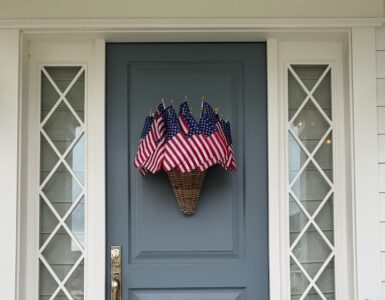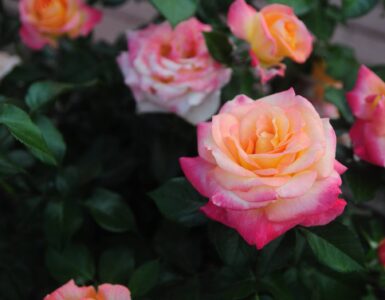Pull off the latest design trend in your own home. Floating shelves give any
room an instant update. Interior Designer, Brooke Jones, explains how to
create this hip, modern look.
Kitchen
Why use shelves in kitchen instead of upper cabinets?
A. Budget friendly. Using open shelves in a kitchen is a simple and budget
friendly way to update an existing kitchen. Instead of spending thousands
on custom cabinetry, you can spend hundreds on floating shelves.
B. Floating shelves work in both large and small spaces. In small spaces
they open up the site lines, making the room seem much larger. In large
spaces, using open shelving will eliminate the ‘sea’ of cabinetry that can
overpower even the most spacious of kitchens.
C. Open shelving is more efficient that upper cabinets. All the everyday
items are at your fingertips and can be easily spotted versus having to
rummage through cupboard after cupboard, opening door after door.
Family Room
Why use shelves in a family room?
A. Consider your loves and interests, since this is where you can show them
off! Great way to display family portraits, items from travels, etc. It’s a way
of showing off what makes your family unique.
B. Keeps area on either side of the fireplace “open.” If cabinetry was used,
the wall would be too heavy and overwhelming. Also, space above the
cabinetry wouldn’t make sense, as the room in the example has 2 story
ceilings.
Bedroom
Why use shelves in a bedroom?
A. Usually there is not a lot of space for display, as storage case goods
(nightstands, dressers, etc.) take up the majority of the extra square
footage after the bed. Shelves add additional storage/display area without
taking up any of this precious real estate.
B. Break up long, bare walls with shelving.
3 Shelf Examples and Tips:
-Kitchen (Purely a functional space)
A. The #1 concern I hear from people about open shelving is “how will I
keep it looking neat and tidy?” The trick is to place the items you use the
MOST on the bottom shelves for easy access (bowls, glasses, salt & pepper
shakers, etc.). Since these will be used and washed on daily basis, you will
always have an opportunity to straighten things out (like when you’re
unloading the dishwasher) and nothing stays around long enough to gather
dust. Place the not-used-so-much items on the top shelves since they are
harder to reach.
B. EDIT, EDIT, EDIT!!! Only keep items you actually use (who actually uses a
melon baller anyway?) or you think it beautiful. If you haven’t used in it a
year+ and you don’t think the item is gorgeous– get rid of it! (ex.
Inherited miss-matched dishes? Donate them and buy all white.)
C. Always personalize your shelf, even in the kitchen. Add in layer of art
behind the functional items (i.e. use large frame to display your kid’s
artwork, instead of hanging it on the fridge with a magnet. It’s much more
chic and will make your child feel even more special).
-Family Rooms/Bedrooms/Personal Spaces (Purely aesthetic space)
A. LAYER, LAYER, LAYER. Place largest items first + then medium + then
small + step back and revise/edit where needed= layering formula (no one
gets it right the first time, so keep playing with it until it feels “right”).
B. Graduate Levels. Don’t have all items the same height. Make sure you
use tall, medium & short items to keep your eye flowing.
C. Golden Mean. Group like items in groups of 1s, 2s, 3s, 5s, etc.
D. Hang Shelf LOW. Most people hang their shelves too high. Make sure
you hang yours to the items on the shelf are at eye level. You don’t want to
crane your neck up or down to view objects.
-Office (Hybrid of Functional and Aesthetic space)
A. Open/Closed Storage. Shelves are open storage but sometime you have
practical items you need that aren’t so pretty. Use CLOSED storage in
addition to open (document boxes, baskets, files, etc.).
B. Books. Don’t just line up books from left to right. This is boring and
shows no creativity. Have some books vertical, others on their side, and if
you have a book you particularly like, have the book front face out. Stack
accessories on top of books for extra height in objects.
C. Keep functional objects pretty and pretty objects functional (i.e. pencil
cup with matching pencils, not a ‘catch-all’ pencil cup).
D. Repeat Layering/Personalizing/Keep functional items in reach/etc.
DON’Ts
A. DON’T over-accessorize (this is an epidemic in Utah, for some reason).
Remember, “Less is more”.
B. DON’T use anything you don’t find to be useful or beautiful.
C. DON’T use fake flowers and plants. Instead, use natural objects, like
branches, antlers, succulents, coral, etc.
D. DON’T forget to have fun! Nothing is set in stone and there are no rules-
– only guidelines. Your home should be a reflection of you!
For more design ideas and a chance to enter the e-Design board giveaway,
visit Brooke’s blog at
www.modern-sophisticate.blogspot.com















Add comment